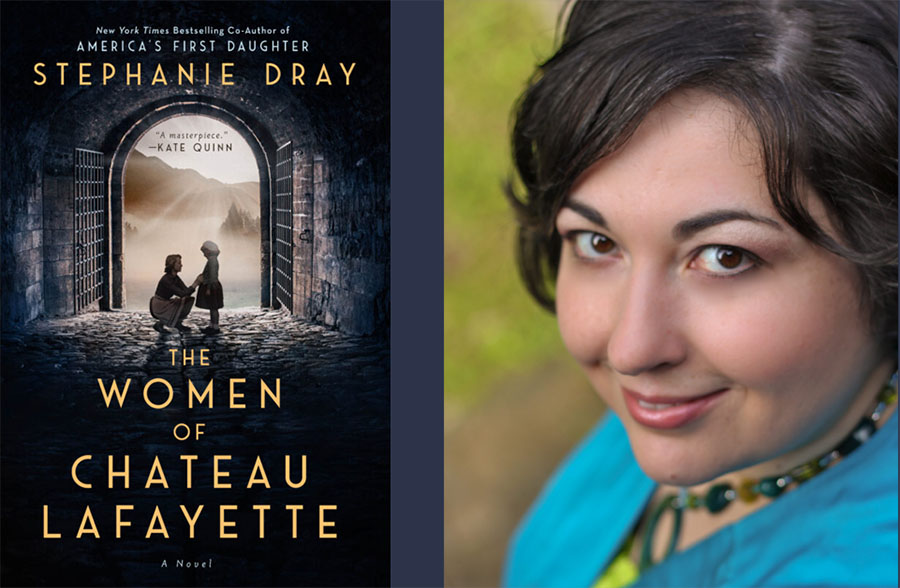
In Stephanie Dray’s ambitious historical novel, “The Women of Chateau Lafayette,” the chateau is a character unto itself. I’m a sucker for stories that connect the past to the present, and even more so when people occupy the same house over centuries. Experiencing how alive someone is as they walk through the halls, breathe in the dust and sleep in their beds while knowing that they will one day cease to exist moves me every time. In the way the country estate of Tom Stoppard’s play “Arcadia” lasts over a 200-year time period and slowly closes the gap between then and now, the chateau Lafayette links three indomitable women — two real historical figures and one fictional — while standing as a symbol for democratic ideals that haven’t changed since 1776.
Adrienne is the wife of General Lafayette, whom we know as the foreign savior in America’s revolutionary war or, for “Hamilton” fans, the world’s favorite fighting Frenchman. But what we don’t know is the role she plays in the French Revolution, the heroine she becomes to her countrymen who think of her as “the mother of France” and the danger she faces to protect her husband and her family.
Beatrice is a socialite in pre-WWI New York, stuck in a loveless marriage and longing to do something lasting without being beholden to any man. She traverses the Atlantic seven times during the war to run a hospital and group home for orphaned children in the very chateau where Adrienne lived with her husband.
Marthe is one of the orphans who grows up in the chateau, preserving the memory of Adrienne through her artistic talents and ultimately helping to harbor French Jewish children from the Nazis and Vichy collaborators.
The reader will enjoy looking for clues connecting each of the time periods. A Christmas candle ceremony over brioche bread that a young Lafayette enjoys with his family is continued with Marthe and her friends as children in the castle. A Jewish soldier in WWI has the same last name as a man hiding in a French countrywoman’s barn during WWII.
Similarly, the chapters work seamlessly with clever connective tissue. One chapter ends with a refusal to sign a letter in 1776, while the subsequent chapter begins with a debate about signing a letter in 1941. It is also fascinating to read how real-life historical figures are woven into the story, such as Winston Churchill, James Madison, Marie Antoinette and “Dr. Franklin,” who comes to bless Adrienne’s child. (This is none other than Benjamin Franklin, then ambassador to France.)
Dray also takes us through the governing politics surrounding the three wars: the struggle between the peasants and nobility, leading up to the beheading of the King Louis XVI and Queen Marie Antoinette; the neutrality stance of President Woodrow Wilson and those who protested his policies, including suffragettes who sent care packages to needy soldiers overseas; Pétain’s collaboration with Hitler and America’s reluctance under FDR to enter the war. In the early pages, it is difficult to keep track of Dray’s depiction of the two world wars, perhaps because the Boche and Nazis are the same German enemy and the sacrifice required of those on the home-front is so similar. And although the book sometimes gets bogged down with political minutia, especially with the gamesmanship of the nobles and royals in Paris and Versailles, the question of not taking a stance versus standing up for what you believe in is a powerful theme. As Marthe struggles to find her role during WWII, she remarks, “Lately, public opinion is like a surreal painting, where contradictory beliefs and prejudices melt together like Dali’s clocks.”
But the emotions and desires of the three women run underneath all the political turmoil. Dray crafts each woman’s romantic relationship skillfully. Dialogue between lovers is original and surprising. And a same-sex plot line is a welcome addition.
A particularly moving moment is when the daughters of a slain WWII Jewish resistance fighter chant the Kaddish for their father with the Christian woman who hid them. Although I would have liked to see a bit more about the plight of the Jews, Dray does paint a vivid picture of anti-Semitism.
When one reads the extensive back-matter of what Dray did not put into the book, one can only imagine how challenging it was to cull through so much history and make a compelling story. This is a wildly impressive novel with characters who fly off the page. “The Women of Chateau Lafayette” unflinchingly describes the toll that war and the fight for democracy takes on us all. And perhaps more poignantly, it reminds us that we are forever connected to our past.
Cambria Gordon is the author of the young adult novel, “The Poetry of Secrets.”
 RSS Feed
RSS Feed















 February 22nd, 2021
February 22nd, 2021  Awake Goy
Awake Goy  Posted in
Posted in  Tags:
Tags: 













